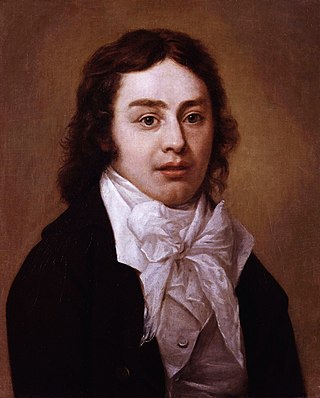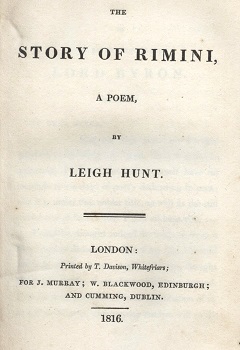
Kubla Khan: or A Vision in a Dream is a poem written by Samuel Taylor Coleridge, completed in 1797 and published in 1816. It is sometimes given the subtitles "A Vision in a Dream" and "A Fragment." According to Coleridge's preface to Kubla Khan, the poem was composed one night after he experienced an opium-influenced dream after reading a work describing Xanadu, the summer capital of the Mongol-led Yuan dynasty of China founded by Kublai Khan. Upon waking, he set about writing lines of poetry that came to him from the dream until he was interrupted by "a person on business from Porlock". The poem could not be completed according to its original 200–300 line plan as the interruption caused him to forget the lines. He left it unpublished and kept it for private readings for his friends until 1816 when, at the prompting of Lord Byron, it was published.

Samuel Taylor Coleridge was an English poet, literary critic, philosopher, and theologian who was a founder of the Romantic Movement in England and a member of the Lake Poets with his friend William Wordsworth. He also shared volumes and collaborated with Charles Lamb, Robert Southey, and Charles Lloyd.

Robert Southey was an English poet of the Romantic school, and Poet Laureate from 1813 until his death. Like the other Lake Poets, William Wordsworth and Samuel Taylor Coleridge, Southey began as a radical but became steadily more conservative as he gained respect for Britain and its institutions. Other romantics such as Byron accused him of siding with the establishment for money and status. He is remembered especially for the poem "After Blenheim" and the original version of "Goldilocks and the Three Bears".

William Hazlitt was an English essayist, drama and literary critic, painter, social commentator, and philosopher. He is now considered one of the greatest critics and essayists in the history of the English language, placed in the company of Samuel Johnson and George Orwell. He is also acknowledged as the finest art critic of his age. Despite his high standing among historians of literature and art, his work is currently little read and mostly out of print.

James Henry Leigh Hunt, best known as Leigh Hunt, was an English critic, essayist and poet.
The Biographia Literaria is a critical autobiography by Samuel Taylor Coleridge, published in 1817 in two volumes. Its working title was 'Autobiographia Literaria'. The formative influences on the work were William Wordsworth's theory of poetry, the Kantian view of imagination as a shaping power, various post-Kantian writers including F. W. J. von Schelling, and the earlier influences of the empiricist school, including David Hartley and the Associationist psychology.
The Lake Poets were a group of English poets who all lived in the Lake District of England, United Kingdom, in the first half of the nineteenth century. As a group, they followed no single "school" of thought or literary practice then known. They were named, only to be uniformly disparaged, by the Edinburgh Review. They are considered part of the Romantic Movement.
Nationality words link to articles with information on the nation's poetry or literature.
Nationality words link to articles with information on the nation's poetry or literature.

"Ode: Intimations of Immortality from Recollections of Early Childhood" is a poem by William Wordsworth, completed in 1804 and published in Poems, in Two Volumes (1807). The poem was completed in two parts, with the first four stanzas written among a series of poems composed in 1802 about childhood. The first part of the poem was completed on 27 March 1802 and a copy was provided to Wordsworth's friend and fellow poet, Samuel Taylor Coleridge, who responded with his own poem, "Dejection: An Ode", in April. The fourth stanza of the ode ends with a question, and Wordsworth was finally able to answer it with seven additional stanzas completed in early 1804. It was first printed as "Ode" in 1807, and it was not until 1815 that it was edited and reworked to the version that is currently known, "Ode: Intimations of Immortality".
Hero and Leander is a poem by Leigh Hunt written and published in 1819. The result of three years of work, the poem tells the Greek myth of Hero and Leander, two lovers, and the story of their forlorn fate. Hunt began working on the poem during the summer of 1816, arousing the interest of the publisher John Taylor, and despite repeated delays to allow Hunt to deal with other commitments the poem was finished and published in a collection 1819. Dealing with themes of love and its attempt to conquer nature, the poem does not contain the political message that many of Hunt's works around that time do. The collection was well received by contemporary critics, who remarked on its sentiment and delicacy, while more modern writers such as Edmund Blunden have criticised the flow of its narrative.

Juvenilia; or, a Collection of Poems Written between the ages of Twelve and Sixteen by J. H. L. Hunt, Late of the Grammar School of Christ's Hospital, commonly known as Juvenilia, was a collection of poems written by James Henry Leigh Hunt at a young age and published in March 1801. As an unknown author, Hunt's work was not accepted by any professional publishers, and his father Isaac Hunt instead entered into an agreement with the printer James Whiting to have the collection printed privately. The collection had over 800 subscribers, including important academics, politicians and lawyers, and even people from the United States. The critical and public response to Hunt's work was positive; by 1803 the collection had run into four volumes. The Monthly Mirror declared the collection to show "proofs of poetic genius, and literary ability", and Edmund Blunden held that the collection acted as a predictor of Hunt's later success. Hunt himself came to despise the collection as "a heap of imitations, all but absolutely worthless", but critics have argued that without this early success to bolster his confidence Hunt's later career could have been far less successful.
The Literary Pocket-Book was a collection of works edited by Leigh Hunt and containing material by Hunt, Percy Bysshe Shelley, John Keats, and Bryan Waller Procter. The collection was put together during 1818, and proved so successful that Hunt was able to sell the copyright for £200 a year later. The collection includes written worked, lined pages to write notes on and lists of authors, artists, schools and libraries. It was a public success, bringing new readers to both Shelley and Keats, and served as a model for other collections of poetry written during the Victorian era. Critical reviews were also excellent, with The London Magazine describing it as "for the most part delightfully written", although Keats himself later wrote that the collection was "full of the most sickening stuff you can imagine".

The Descent of Liberty was a masque written by Leigh Hunt in 1814. Held in Horsemonger Lane Prison, Hunt wrote the masque to occupy himself, and it was published in 1815. The masque describes a country that is cursed by an Enchanter and begins with shepherds hearing a sound that heralds change. The Enchanter is defeated by fire coming out of clouds, and the image of Liberty and Peace, along with the Allied nations, figures representing Spring and art, and others appear to take over the land. In the final moments, a new spring comes and the prisoners are released. It is intended to represent Britain in 1814, emphasising freedom and focusing on the common people rather than the aristocracy. Many contemporary reviews from both Hunt's fellow poets and literary magazines were positive, although the British Critic described the work as a "pert and vulgar insolence of a Sunday demagogue, dictating on matters of taste to town apprentices and of politics to their conceited masters".

The Story of Rimini was a poem composed by Leigh Hunt, published in 1816. The work was based on his reading about Paolo and Francesca in hell. Hunt's version gives a sympathetic portrayal of how the two lovers came together after Francesca was married off to Paolo's brother. The work promotes compassion for all of humanity and the style served to contrast against the traditional 18th century poetic conventions. The work received mixed reviews, with most critics praising the language.
The Nymphs was composed by Leigh Hunt and published in Foliage, his 1818 collection of poems. The work describes the spirits of a rural landscape that are connected to Greek mythology. The images serve to discuss aspects of British life along with promoting the freedom of conscience for the British people. The collection as a whole received many attacks by contemporary critics, but later commentators viewed the poem favourably.
The Calendar of Nature is a series of articles by Leigh Hunt about aspects of various months and seasons published throughout 1819 in the Examiner. It is also included in his Literary Pocket-Book and published on its own as The Months. The work places emphasis on the season of autumn as a time for justice and prosperity, and influenced John Keats's poem "To Autumn". The emphasis on both works is on a temperate landscape and the positive political aspects of living in such a place. The work also stresses the sickness that is connected to a temperate landscape, which is related to the physical problems that Keats was suffering from at the time.

The sonnet was a popular form of poetry during the Romantic period: William Wordsworth wrote 523, John Keats 67, Samuel Taylor Coleridge 48, and Percy Bysshe Shelley 18. But in the opinion of Lord Byron sonnets were “the most puling, petrifying, stupidly platonic compositions”, at least as a vehicle for love poetry, and he wrote no more than five.

The Spirit of the Age is a collection of character sketches by the early 19th century English essayist, literary critic, and social commentator William Hazlitt, portraying 25 men, mostly British, whom he believed to represent significant trends in the thought, literature, and politics of his time. The subjects include thinkers, social reformers, politicians, poets, essayists, and novelists, many of whom Hazlitt was personally acquainted with or had encountered. Originally appearing in English periodicals, mostly The New Monthly Magazine in 1824, the essays were collected with several others written for the purpose and published in book form in 1825.

Romanticism was an artistic, literary, and intellectual movement that originated in Europe toward the end of the 18th century. Scholars regard the publishing of William Wordsworth's and Samuel Coleridge's Lyrical Ballads in 1798 as probably the beginning of the movement in England, and the crowning of Queen Victoria in 1837 as its end. Romanticism arrived in other parts of the English-speaking world later; in the United States, about 1820.












